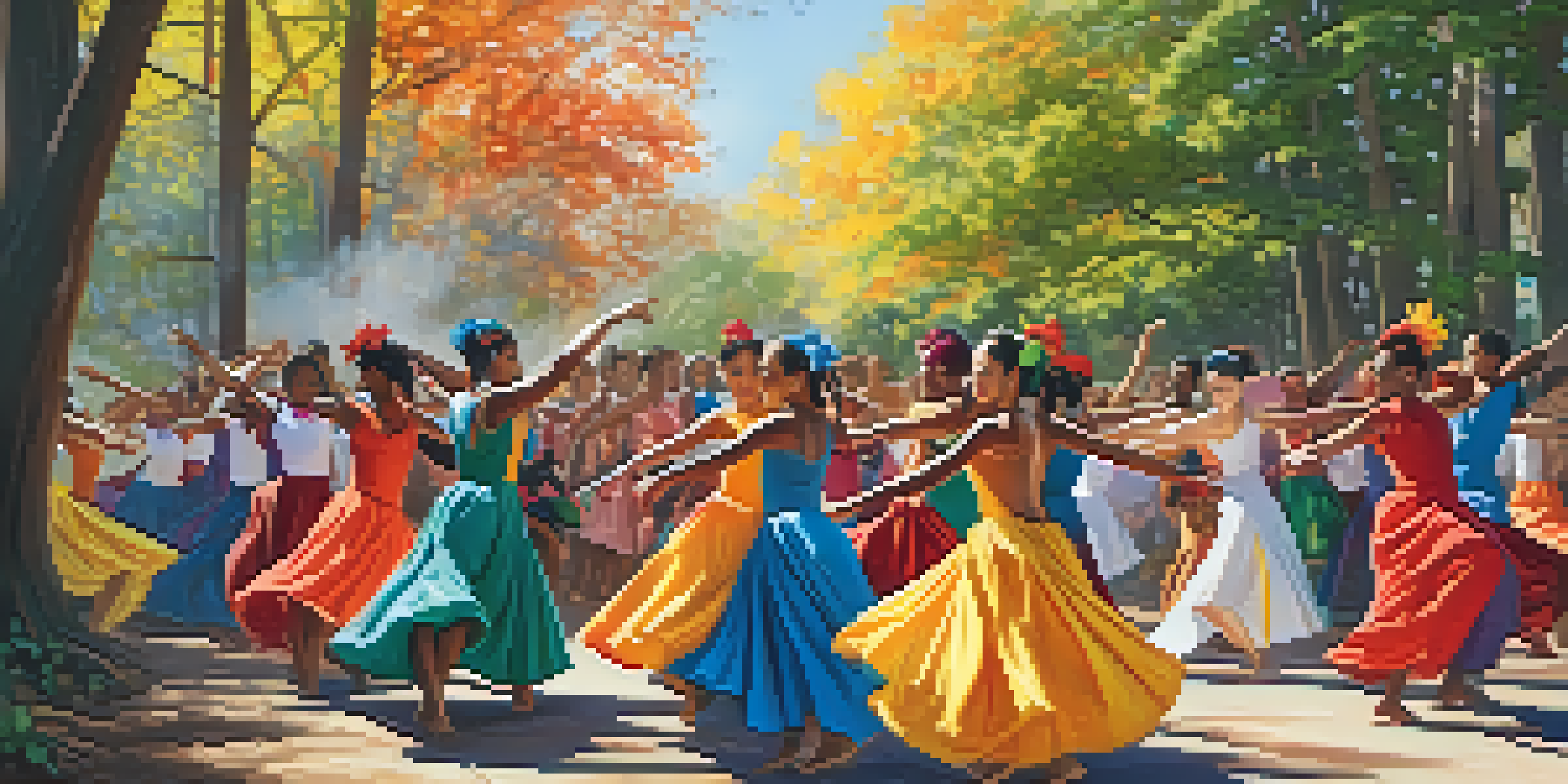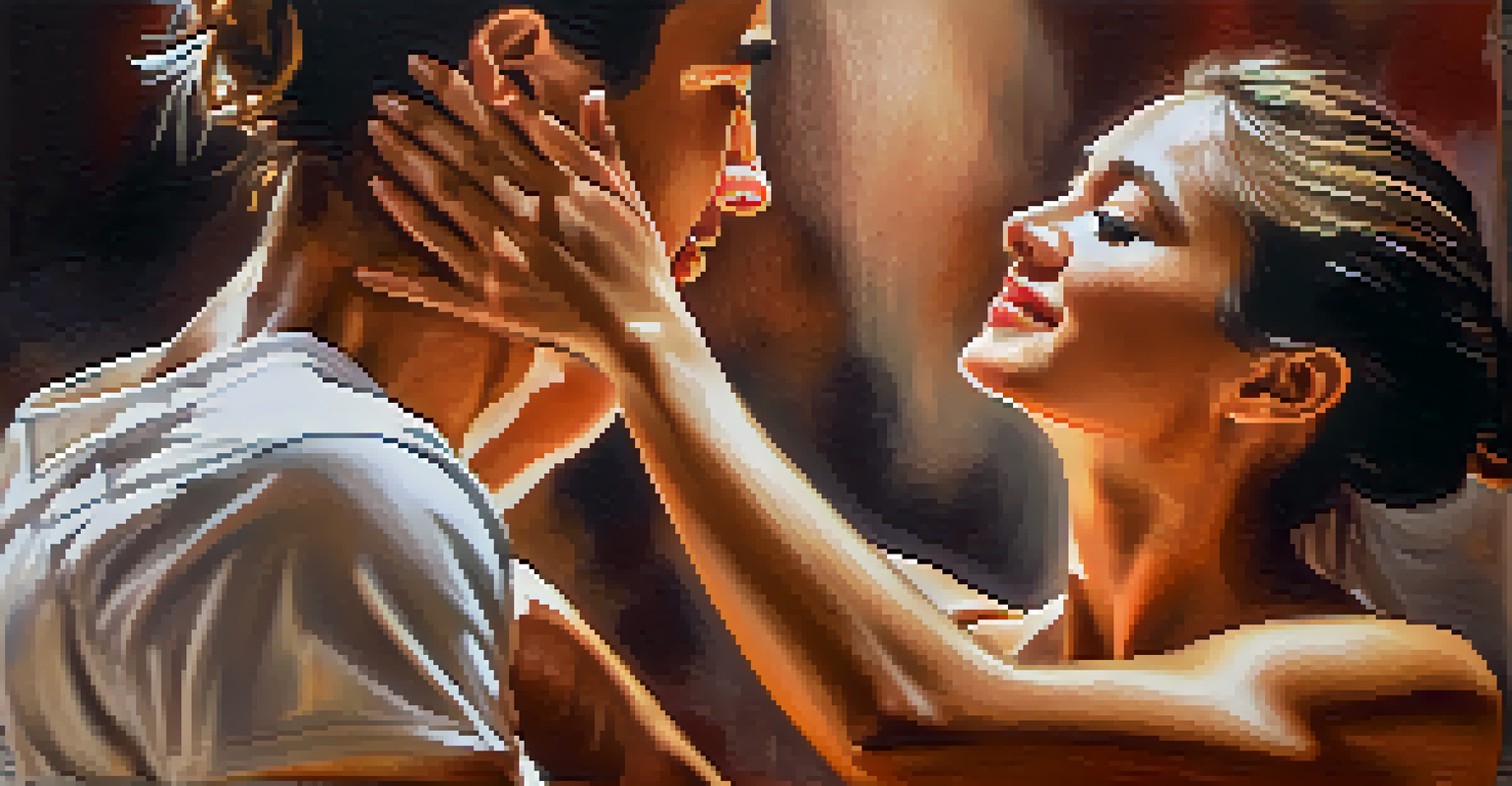Dance as a Non-Verbal Tool for Conflict Resolution

Understanding Dance as a Form of Expression
Dance transcends spoken language, allowing individuals to express emotions and feelings in a visceral way. Through movement, dancers can convey joy, sadness, anger, or frustration—emotions that might be difficult to articulate verbally. This non-verbal communication can bridge gaps in understanding, especially in conflict situations where words may fail.
Dance is the hidden language of the soul.
When people engage in dance, they tap into their bodies and instincts, fostering a deeper connection to their emotions. This physical expression can often resonate with others on a level that words cannot reach. It creates a shared experience, facilitating empathy and understanding among participants.
By embracing dance as a form of expression, individuals can explore their feelings and those of others, creating a safe space for dialogue that is rooted in movement rather than language. This means that even when conflicts arise, the act of dancing together can help to diffuse tension and foster collaboration.
The Role of Rhythm in Conflict Resolution
Rhythm serves as a universal language that can unify individuals from diverse backgrounds. In the context of conflict resolution, finding a common rhythm can symbolize a shared goal or understanding, making it easier for parties to connect. Just as musicians synchronize their beats, dancers can align their movements, creating harmony even amidst discord.

When participants engage in rhythmic dance, they may find themselves naturally harmonizing, which can ease feelings of hostility. This synchronization of movements mirrors the process of coming together to resolve differences, emphasizing the importance of cooperation and mutual respect. The act of following a rhythm can also shift focus away from individual grievances toward collective expression.
Dance as Non-Verbal Expression
Dance allows individuals to express complex emotions that words may fail to convey, fostering empathy and understanding.
Ultimately, rhythm not only enhances the dance experience but also reinforces the message that resolution is possible when individuals work together. Through shared rhythm, conflicts can be approached with a sense of unity rather than division.
The Impact of Movement on Emotions
Movement has a profound impact on our emotional state, often influencing how we feel and respond to situations. Engaging in dance can release pent-up emotions, allowing individuals to process feelings in a constructive way. This release can be particularly beneficial in conflict situations, where emotions may be running high.
To dance is to be out of yourself. Larger, more beautiful, more powerful. It is glory on earth and it is yours for the taking.
As dancers express themselves through movement, they can experience a cathartic release that helps in alleviating stress and anxiety. For example, a group of individuals might participate in a dance circle, channeling their frustrations into powerful movements that signify their struggles. This physical outlet can shift the atmosphere from one of tension to one of healing.
Moreover, as individuals witness each other's expressions through dance, a sense of understanding can emerge. This shared emotional experience not only fosters connection but also encourages participants to approach conflicts with empathy and openness.
Building Empathy Through Dance
Dance encourages participants to step into each other’s shoes, fostering empathy and understanding. When individuals dance together, they must attune to each other’s movements, which requires a level of awareness and sensitivity. This connection can help participants appreciate different perspectives, essential for resolving conflicts.
As dancers engage in improvisation or partner work, they learn to respond to the needs and cues of others. This practice of tuning in can translate into real-life situations, where understanding and compassion are crucial in resolving disputes. The act of moving together promotes a sense of unity that can soften rigid positions.
Rhythm Unites for Resolution
Finding a common rhythm in dance helps participants connect, emphasizing cooperation and mutual respect in conflict resolution.
Furthermore, the vulnerability inherent in dance can allow individuals to express their true selves, breaking down barriers that often contribute to conflict. By creating an environment of trust and openness, dance becomes a powerful tool for building empathy and understanding.
Creating Safe Spaces for Dialogue
Dance can serve as a catalyst for creating safe spaces where individuals feel comfortable expressing their thoughts and feelings. In conflict resolution, it’s vital to foster an environment where all parties feel heard and respected. Dance provides a dynamic setting that encourages open dialogue through movement rather than confrontation.
By engaging in dance, participants can lower their defenses and approach discussions more openly. The physical act of moving together can alleviate tension and create a sense of belonging, allowing individuals to share their perspectives without fear of judgment. This comfort can lead to more authentic and productive conversations.
Moreover, as people engage in dance, they may find common ground that can serve as a foundation for future discussions. The act of collaborating in movement can remind participants of their shared humanity, paving the way for resolution and reconciliation.
Cultural Relevance of Dance in Conflict Resolution
Dance is often deeply rooted in cultural identity, making it a powerful tool for bridging cultural divides in conflict resolution. Different cultures have their own unique dance forms that tell stories, share traditions, and express collective emotions. By incorporating dance into conflict resolution, individuals can honor cultural differences while finding commonality.
For instance, community-based dance initiatives can bring together diverse groups to celebrate their unique heritages while addressing shared challenges. These cultural expressions can help participants appreciate the richness of each other's backgrounds, fostering a sense of respect and camaraderie. Understanding and valuing cultural differences is essential for effective conflict resolution.
Creating Safe Spaces Through Dance
Engaging in dance creates a comfortable environment for open dialogue, enabling participants to express their thoughts and feelings freely.
In this way, dance not only serves as a means of expression but also as a cultural dialogue that encourages collaboration and understanding. Embracing dance in conflict resolution allows participants to celebrate diversity while working toward a common goal.
Practical Steps to Use Dance for Conflict Resolution
To effectively use dance as a tool for conflict resolution, it’s essential to create a structured environment where participants feel safe and encouraged to express themselves. Begin by choosing an appropriate dance style that resonates with the group, whether it’s hip-hop, salsa, or traditional folk dances. This choice can set the tone for the session and help participants feel more engaged.
Next, incorporate activities that promote collaboration, such as partner dancing or group improvisation. These activities not only foster connection but also encourage participants to communicate through movement, enhancing their non-verbal dialogue. By focusing on collaboration rather than competition, the group can work toward mutual understanding and resolution.

Lastly, allow time for reflection and discussion after the dance session. Encourage participants to share their experiences and insights gained through movement. This debriefing can solidify the lessons learned and help participants navigate future conflicts with newfound empathy and understanding.